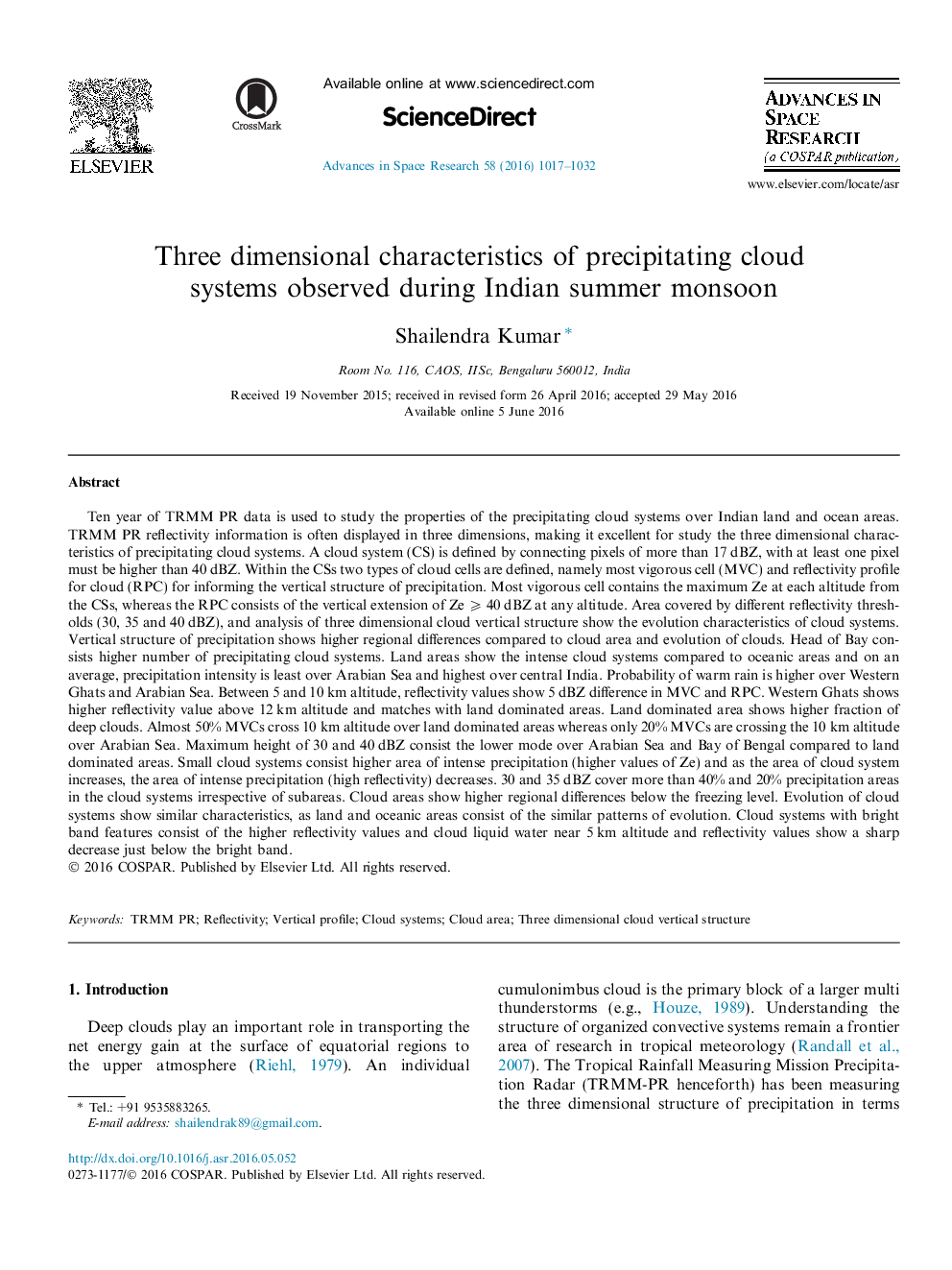| کد مقاله | کد نشریه | سال انتشار | مقاله انگلیسی | نسخه تمام متن |
|---|---|---|---|---|
| 1763216 | 1019989 | 2016 | 16 صفحه PDF | دانلود رایگان |
عنوان انگلیسی مقاله ISI
Three dimensional characteristics of precipitating cloud systems observed during Indian summer monsoon
ترجمه فارسی عنوان
ویژگی های سه بعدی از سیستم های ابر رسانا که در فصل گرمسیری هندی دیده می شوند
دانلود مقاله + سفارش ترجمه
دانلود مقاله ISI انگلیسی
رایگان برای ایرانیان
موضوعات مرتبط
مهندسی و علوم پایه
علوم زمین و سیارات
علوم فضا و نجوم
چکیده انگلیسی
Ten year of TRMM PR data is used to study the properties of the precipitating cloud systems over Indian land and ocean areas. TRMM PR reflectivity information is often displayed in three dimensions, making it excellent for study the three dimensional characteristics of precipitating cloud systems. A cloud system (CS) is defined by connecting pixels of more than 17 dBZ, with at least one pixel must be higher than 40 dBZ. Within the CSs two types of cloud cells are defined, namely most vigorous cell (MVC) and reflectivity profile for cloud (RPC) for informing the vertical structure of precipitation. Most vigorous cell contains the maximum Ze at each altitude from the CSs, whereas the RPC consists of the vertical extension of Ze ⩾ 40 dBZ at any altitude. Area covered by different reflectivity thresholds (30, 35 and 40 dBZ), and analysis of three dimensional cloud vertical structure show the evolution characteristics of cloud systems. Vertical structure of precipitation shows higher regional differences compared to cloud area and evolution of clouds. Head of Bay consists higher number of precipitating cloud systems. Land areas show the intense cloud systems compared to oceanic areas and on an average, precipitation intensity is least over Arabian Sea and highest over central India. Probability of warm rain is higher over Western Ghats and Arabian Sea. Between 5 and 10 km altitude, reflectivity values show 5 dBZ difference in MVC and RPC. Western Ghats shows higher reflectivity value above 12 km altitude and matches with land dominated areas. Land dominated area shows higher fraction of deep clouds. Almost 50% MVCs cross 10 km altitude over land dominated areas whereas only 20% MVCs are crossing the 10 km altitude over Arabian Sea. Maximum height of 30 and 40 dBZ consist the lower mode over Arabian Sea and Bay of Bengal compared to land dominated areas. Small cloud systems consist higher area of intense precipitation (higher values of Ze) and as the area of cloud system increases, the area of intense precipitation (high reflectivity) decreases. 30 and 35 dBZ cover more than 40% and 20% precipitation areas in the cloud systems irrespective of subareas. Cloud areas show higher regional differences below the freezing level. Evolution of cloud systems show similar characteristics, as land and oceanic areas consist of the similar patterns of evolution. Cloud systems with bright band features consist of the higher reflectivity values and cloud liquid water near 5 km altitude and reflectivity values show a sharp decrease just below the bright band.
ناشر
Database: Elsevier - ScienceDirect (ساینس دایرکت)
Journal: Advances in Space Research - Volume 58, Issue 6, 15 September 2016, Pages 1017-1032
Journal: Advances in Space Research - Volume 58, Issue 6, 15 September 2016, Pages 1017-1032
نویسندگان
Shailendra Kumar,
